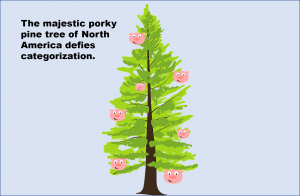64 Imagery
What is imagery?
In terms of writing, imagery is more than creating a pretty picture for the reader. Imagery pertains to a technique for the writer to appeal to the reader’s five senses as a means to convey the essence of an event. The five senses include sight, sound, smell, touch, and taste. The writer does not need to employ all five senses, only those senses that most effectively convey, transport the reader into that event.
Why use imagery?
Imagery engages the reader with specific sensory details. Imagery creates atmosphere/mood, causing the reader to feel a certain emotion. For example, a scary scene includes details that cause a reader to be frightened.
Example from Edgar Allan Poe’s “Masque of the Red Death”
The figure was tall and gaunt, and shrouded from head to foot in the habiliments of the grave. The mask which concealed the visage was made so nearly to resemble the countenance of a stiffened corpse that the closest scrutiny must have had difficulty in detecting the cheat. And yet all this might have been endured, if not approved, by the mad revellers around. But the mummer had gone so far as to assume the type of the Red Death. His vesture was dabbled in blood — and his broad brow, with all the features of the face, was besprinkled with the scarlet horror.
Imagery can be used throughout an entire essay, such as a description essay that focuses on a particular event. Writers should first decide what atmosphere/mood they want to create for their readers and then focus solely on the sensory details that convey that particular atmosphere/mood. For example, if a writer wanted to share the experience of a favorite holiday meal, then s/he would focus on the smells and tastes of all the food and the memories that those smells and tastes conjure. The hectic grocery shopping for all the ingredients would be omitted since that would not express the nostalgia of the meal.
Imagery can also be used per individual paragraph as a means to illustrate a point. For example, in an essay arguing for a ban on smoking, one paragraph could detail the damage to lungs caused by smoking.
Exercise

A brainstorming technique for imagery involves drawing a picture by focusing on one sense at a time. So, find a blank sheet of paper and various colored pencils.
First and easiest would be sight. Slow down to mentally picture every object, shape, color, person, and so on in the scene. Draw, as best you can, representations of each of those visual details. (Only you will see this drawing; no need to stress over perfection.)
Next, take a different sense, such as sounds, and record those sounds on paper with various colors, symbols, or onomatopoeia. (Again, do the best you can to represent what you heard. Your goal is to remind yourself of the sounds, not create a work of art.)
Next, take a different sense and record that particular sense on paper with various colors and symbols.
The objective is to slow down and focus on each sense individually rather than trying to remember the scene all at once. By slowing down and envisioning each sense on paper, you can determine which senses most accurately create the atmosphere/mood for the essay and then apply only those senses in the essay.
Further Reading
